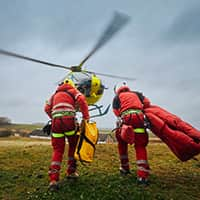An Emergency Preparedness and Disaster Safety Guide for the Workplace
Written by Staff Writer

Natural disasters, such as tornadoes, hurricanes, floods and earthquakes, can occur with little or no warning, leaving homes and workplaces vulnerable to significant damage and disruption. While you cannot control when or where these events happen, you can take proactive steps to reduce their impact and ensure the safety of those in your care.
Tornadoes
Tornadoes are highly destructive and often unpredictable, bringing strong winds and debris that can cause significant damage. To prepare for them, reinforce windows, doors and roofing with durable materials, and secure or remove outdoor objects, like patio furniture, that could become dangerous projectiles. Identify a safe space to go, such as a cellar or an interior room away from windows and exterior doors, and practice emergency drills regularly to ensure that everyone knows what to do. During a tornado, protect yourself under sturdy furniture or with a mattress and stay in your designated safe area until authorities signal the all-clear.
- Be Prepared for a Tornado
- Preparing for a Tornado
- How Tornadoes Work
- Are You Ready for a Tornado?
- Staying Safe in a Tornado
Earthquakes
If you live or work in an earthquake-prone area, secure heavy furniture like bookcases and mirrors to the walls and add latches to cabinet doors to prevent contents from spilling. Large appliances and medical equipment for people with special needs should also be firmly anchored.
When an earthquake occurs, take immediate shelter under a sturdy table, staircase or desk to protect yourself from falling debris. Teach children safe hiding spots in their rooms for nighttime tremors and consider installing grab bars near the bed for individuals with limited mobility to help them move to safety. It's also important to be cautious of aftershocks, as they can follow the main quake and cause additional damage or danger.
- How Do Earthquakes Affect Buildings?
- What Should I Do Before, During and After an Earthquake?
- Workplace Safety for California Employees
- Seven Steps to Earthquake Safety
- Earthquake Safety and Workplace Preparedness Guidelines
- Fall Prevention in the Workplace
- Earthquake Safety Tips
- Workplace Safety Training
Tsunamis
If your workplace or home is near the coast, plan ahead for the possibility of a tsunami. If a tsunami is imminent, the priority is to move quickly and efficiently both inland and upward. Make an evacuation plan for how you'll get as far away from the coastline as possible and head to the highest ground available. When you need to evacuate due to an approaching tsunami, make sure that children, people with disabilities and pets are safely accounted for and traveling with you, ideally holding onto one another for security.
- Tsunami Safety
- What Should You Do in the Event of a Tsunami?
- Tsunami Safety Rules
- Tsunami Preparedness
Hurricanes
Hurricanes, while predictable to some extent, can still be highly destructive. Before a storm hits, do everything you can to secure the exterior of your home and your workplace, including installing storm shutters and reinforcing doors and roofs. Safeguard critical equipment by elevating it above potential flood levels, and make sure that backup generators are operational and well-maintained.
Stock emergency supplies in your office and your home, including first aid kits, flashlights, water and non-perishable food. Establish a communication plan that details how you'll pass along crucial information like evacuation orders, safety protocols or workplace closures. Monitor local weather reports, and follow evacuation orders promptly. Do not return until authorities declare that it's safe.
Blizzards
Blizzards can confine people for days and cause significant damage. Homeowners in areas with harsh winters should insulate their pipes, replace worn siding and roofing and clean the gutters regularly to prevent ice buildup. Proper insulation of doors and windows, especially in bedrooms, is also essential. Have your roof checked to make sure that it can bear the weight of heavy snow.
Emergency kits for blizzard-prone areas should include a week's supply of medications, care items, extra blankets and clothing. In workplaces, preparation should include assessing the building's insulation, ensuring that heating systems are functional, and maintaining emergency supplies like nonperishable food, water, blankets, flashlights and batteries.
Businesses should develop communication plans for closures or remote work and establish protocols for employees to leave safely during worsening conditions. They should also have a backup plan for in case employees end up snowed in at work.
- What to Know About Safety During a Blizzard
- Tips for Staying Safe and Warm During Power Outages, Ice Storms, and Blizzards
- Winter Weather Safety: Blizzards, Snow, Ice, and Freezing Rain
- Snow and Blizzard Hazards & Safety Information
Wildfires
Protecting your home or workplace from wildfires starts with smart landscaping designed to create a firebreak. Clear debris, such as leaves and sticks, from your yard, particularly within 30 feet of your home, and get rid of dead plants. Keep your gutters clean, and keep your lawn trimmed. It's also important to treat structures like houses, patios, doghouses or play equipment with flame-resistant materials when possible.
Be sure to check local regulations, as some regions have specific wildfire preparation requirements. Employers should also have an evacuation plan in place, stock emergency kits with masks, water, first aid supplies and key contact information, and monitor air quality during wildfire season to determine whether remote work or schedule adjustments are necessary.
- 10 Tips to Prevent Wildfires
- Guide to Staying Safe During Wildfires
- Fire Safety Education for Employees
- Protecting Yourself, Family and Property During a Wildfire
- Basic First Aid Training for General Emergencies
- Guidelines for Fire Extinguishers in the Workplace
- Wildfires: Protect Yourself and Your Community
